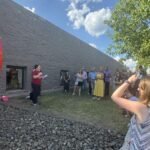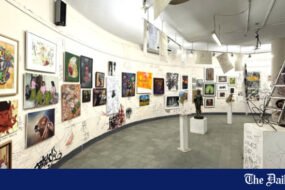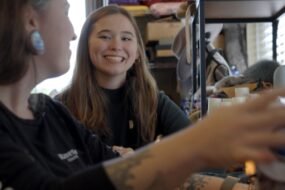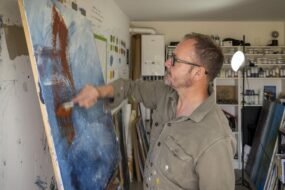
Boxcars season opener: Pregame sights and sounds
Here are pregame sights and sounds from the Hagerstown Flying Boxcars’ 2025 season opener at Meritus Park.
- The Washington County Museum of Fine Arts, founded by Anna and William Singer, opened in 1931 and has offered free admission since its inception.
- The museum aims to be a community hub, providing art education, cultural experiences and a space for contemplation and learning.
- With a collection exceeding 8,000 items, the museum serves local residents and attracts visitors from outside Washington County.
Ninety-seven years ago this month, museum founder Anna Singer thanked Hagerstown Mayor C.E. Bowman for his “kindness in donating a beautiful spot in the Park on which to place the building.”
About two-and-a-half years later (September 1931) that building, the Washington County Museum of Fine Arts, constructed on that beautiful spot, opened to the public. Since then, the museum has offered free admission. Even in 1928, Anna Singer imagined the museum as a place that would grow with the community and its need. For example, in founding documents, she said: “Our intention is to build the first unit of the museum … our wish is to make the building one worthy of the treasures it will house … with a dignity and beauty befitting its purpose. As necessity demands, other units, or wings shall be added.”
Established by Hagerstown-born Singer and her Pittsburgh steel-heir husband, William Henry Singer, Jr., the museum was ambitiously envisioned to be a regional arts and culture center. The Singer legacy included a commitment to both free admission and to providing a wide variety of low-cost programs and experiences. Anna was an accomplished pianist and it was important to her that the museum be a site for a variety of enlightening cultural experiences, including hands-on learning for children and regular music programs in addition to art exhibitions. The Singers also hoped, … that all who care to enter the museum will find a haven of rest where peace and beauty will always dwell, and where, in the contemplation of beautiful works of art, joy will be brought into their lives which otherwise they never could have known.
As Executive Director of the museum, my job is to envision, strengthen, and expand its role in the community, and these days it feels more urgent than ever. When I am out speaking to local groups, I often tell people I do my job with a heightened sense of responsibility because I not only know how close this museum is to the hearts of this community — I feel it. It’s a privilege to be entrusted with caring for this treasured community legacy and to work to grow its impact.
Museums have evolved over the last 90 years from places of contemplation and thought (secular “temples”), to places of formal and informal active learning, socializing, and community building for all ages. The Singers believed in the power of art to transform individual lives and enrich the community, and those of us who work here, do, too. We know, for example, how a museum benefits our young people; consider, for example, our Saturday Morning Youth Program, our formal partnerships supporting school curricula, and how we serve secondary education through internships, field trips, and an annual scholarship to a high school student interested in pursuing the arts.
To embrace, welcome, and build community, we offer special days of all-ages programming for each exhibition; holiday evenings in December with extended hours; and a summer series, Garden Nights at the Museum, which features outdoor music and evening hours. This year, our Garden Nights are scheduled for July 11, Aug. 8, and Sept. 12—so please grab some friends and a picnic basket and join us.
Experiencing and interacting with the arts is hugely important to all of us as individuals, as families and as community members. Art brings us together — and mends and strengthens our social fabric. Art helps us to think, grow, learn, wonder and feel. It improves our wellbeing and reduces stress, and it helps us understand others, see new perspectives and empathize. It brings us joy and activates curiosity.
The health impact is real, and the recognition of the physiological and psychological benefits of museums visits has been widely circulated lately in news stories about doctors in Canada and Switzerland (and elsewhere too, I hope) actually writing prescriptions for museum visits. Studies show that communities with robust cultural amenities even have lower crime rates (and this applies perhaps most significantly to areas with lower-than-average incomes, so I’m not talking about the arts as an amenity solely for the wealthy).
Over our more than 90 years, we’ve grown the collection to more than 8,000 items, and served seven generations of families and children who have taken pride in showing off their creations in the annual Washington County Public Schools Exhibition. Seven generations who have been moved by the beauty of Diana of the Chase, awe-struck by the grandeur of the Schreiber Gallery, charmed by the American vision of Norman Rockwell, impressed by the talents of their neighbors in the Cumberland Valley exhibitions, and moved by the quality of our remarkable collection.
In another piece of correspondence, Anna Singer evocatively describes the museum as “this house of the beautiful.” It’s more complicated than that; we are, of course a “house of the beautiful,” with dazzling portraits, soothing landscapes, exquisite art glass — all part of our outstanding collection — but we’re also a space for your own creativity, and for ideas and conversations that might provoke you more than soothe you.
If you have visited, you likely know we ask your zip code when you enter the building. Our data tell us that about half of our more than 45,000 annual visitors come from outside Washington County. Those folks, whether here on day trips or for longer, help spur regional tourism and create a positive economic impact locally, whether making a purchase in the museum store, attending a class, concert, or other program, or going elsewhere for lunch or dinner. Our economic impact has been estimated at least $4 to 6 million annually.
We are looking forward to an exciting summer in which we hope to leverage all these areas of museum impact. We’ll have a wide assortment of programming related to our upcoming major exhibition Frida Kahlo: Picturing an Icon, an exhibition of the artist’s personal photographs. We have expanded our marketing to bring more visitors to the museum and the county. We’ll have summer camp, concerts, tours, and other programs all built around themes related to the exhibition and Kahlo’s distinctive style and approach to art-making that was deeply personal and revelatory, while also embracing the traditional style and approach of her Mexican heritage. When you learn just a little bit of Frida Kahlo’s story, you’ll know that she clearly understood the benefit of making art to process experience, to understand others, to express herself, to heal, and to connect with others. It’s what artists and museum do individually and collectively. It’s what we do in this “house of the beautiful.”
Sarah Hall is the executive Director of Washington County Museum of Fine Arts.









